2012: A Landmark Year for Historic Preservation
The Commission for Historical and Architectural Preservation
(CHAP) and the Planning Department is pleased to announce designation of eleven
new Baltimore City Landmarks in 2012, This brings the Landmark list to a total
of 172 exterior designations, and two public interior designations. A majority of
the new landmarks are in downtown Baltimore, and represent a broad range of
Baltimore history and architectural styles.
Baltimore’s landmarks help to define the physical identity
and character of the city, and contribute greatly to the city’s vitality. The
designation of these properties as landmarks protects them for future
generations, honors the stewards of these significant places, and affords
owners the opportunity to access local tax credits.
 CHAP staff works collaboratively with members of the City
Council, community leaders, citizens, and organizations in the process of designating historic landmarks.
The Downtown
Partnership of Baltimore has been a strong partner and leader in the
designation of significant buildings in Baltimore’s central business district. In the past few years, downtown Baltimore has
blossomed into the fastest-growing
residential market in the city.
|
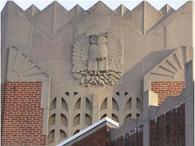 The majority of these new housing units are
located in early-20th century offices and warehouse buildings. The
adaptive reuse of these historic buildings brings renewed life to the
structures, and tenants have an appreciation for these unique spaces with their
finely-crafted original details and rich histories. The Downtown Partnership strongly
promotes the reuse and protection of these buildings, and CHAP will continue to
work closely with them to designate more landmarks in 2013.
|
The designation of St. Mark’s Evangelical Lutheran Church as
the second Public Interior landmark has garnered some well-deserved interest in
the church interior, with a front page article
in the Baltimore Sun in November. Louis Comfort Tiffany was one of America’s most famous interior designers
and artists of the late 19th - early 20th century, though today he is best
known for his stained-glass. The interior of St. Mark’s was designed by the
Tiffany Glass and Decorating Company, and it is one of the few intact
Tiffany-designed interiors left in the world.
If you’d like to learn more about Baltimore’s historic
landmarks, you can view or download a copy of CHAP’s updated Designated
Landmarks List. In 2013, CHAP staff will
continue to work with our partners to designate more of Baltimore’s significant
historic places to the Baltimore City Landmark List. For more information on
landmark designation, or to request a designation, contact Lauren Schiszik at
lauren.schiszik@baltimorecity.gov or 410-396-5796.
New Landmarks of 2012:
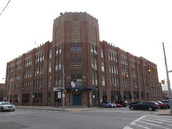
Old Dunbar High School
– 540 N. Caroline St. (Landmark #163)
Dunbar
Junior-Senior High School PS 133 opened in 1932 as a junior high school in this
Art Deco school building, expanding to include high school in 1940. Dunbar was
the only high school for African Americans in East Baltimore until
desegregation in 1954. Dunbar has a legacy of providing equitable, high-quality
education and played an important role in the community of East Baltimore for
the majority of the 20th century.
|
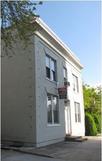
Shelley House – 3849
Roland Ave. (Landmark #164)
Located in
Hampden, the Shelley House is the oldest documented concrete house in Baltimore
City, built in 1905-1906. Designed by Baltimore architect John E. Lafferty for
local
physician Dr. Albert Shelley, this Colonial Revival home is an early example of
reinforced concrete used in domestic architecture, predating many other
concrete homes locally and nationally. Concrete was an early 20th century
“miracle” building material that was versatile and fireproof, and gained
popularity as an architectural material throughout the 20th century.
|
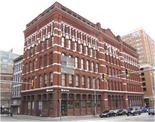
Abell Building – 329-335 W. Baltimore St. (Landmark #165)
The Abell Building is an ornately
decorated late-19th century double warehouse. It was constructed in
1880 for A.S. Abell, owner of the Baltimore Sun, and served as one of his
investment properties. Designed by prominent Baltimore architect George A.
Frederick, this structure is one of the finest Victorian warehouses in
Baltimore, and is considered to be Frederick’s best industrial design. It
features cast-iron on the first floor and brick with polychromatic stone
details on the upper stories. The ironwork was cast by Bartlett, Hayward &
Co. The building survived the Great Fire of 1904, and housed a variety of
businesses and manufacturing firms.
|
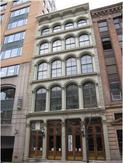
Appold-Faust
Building – 307-309 W. Baltimore St. (Landmark #166)
The
Appold-Faust Building is a late-19th century iron-front factory and
warehouse, and is one of the finest examples of cast-iron architecture in the
City. It is the only known existing building in the City that has two cast-iron
façades. Cast-iron architecture was once ubiquitous in the business district.
The building was constructed in 1870 by prominent builder Benjamin F. Bennett,
and the ironwork likely cast by the foundry of Bartlett, Robbins, and Co. for
George J. Appold, a prominent Baltimore businessman. The rear of the building was
constructed in 1875 for John Faust, a pioneer in machinated shoe manufacturing.
The building housed a variety of businesses and manufacturing firms,
representative of how the garment district grew and changed throughout its
history
|
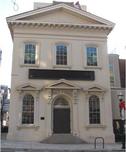
Baltimore
Equitable Society Building – 21 N. Eutaw St. (Landmark # 167)
The Baltimore Equitable Society Building was constructed in
1857 for the Eutaw Savings Bank of Baltimore. The architect was Joseph F. Kemp
and the builders were Gardner & Matthews. The building is Italian Renaissance
Revival, a style that once was common in the city, but has mostly disappeared
due to the Great Fire of 1904, urban renewal, and redevelopment. In 1889, the
Baltimore Equitable Society moved into this building, where it remained until
2003. As the city’s first fire insurance company and the state’s first
corporation, Baltimore Equitable Society has insured city residents against
fire since 1794.
|

Equitable
Building – 10-12 N. Calvert St. (Landmark # 168)
The Equitable
Building is significant as the first skyscraper in Baltimore. It was the
largest and most highly decorated office building in Baltimore when it was
constructed in 1891-1893, and is the oldest existing building on Courthouse
Square. This commercial building was designed in the Italian Renaissance Revival
style by prominent Baltimore architects Charles L. Carson and Joseph Evans
Sperry, and features elements of Sullivanesque architecture. The Equitable
Building was the first building in Baltimore to be constructed with a “cage” of
cast-iron girders and columns supporting the steel floor beams independent from
the exterior framing of the building. The building was fireproof, and survived
the Baltimore Fire of 1904, though the interior was destroyed. It was one of
several fireproof office buildings that helped stop the fire from spreading
further north. Throughout its existence, the Equitable Building has housed
offices of businesses, banks, insurance, and law.
|
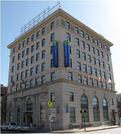
Old Town
National Bank Building – 221 N. Gay St. (Landmark #169)
The Old Town
National Bank is an excellent example of an early 20th century
commercial structure in Baltimore. Designed in the Beaux Arts style by Frederic
A. Fletcher, the building served one of the oldest banking houses in the city.
The bank’s history is intrinsically tied to the Old Town neighborhood, and was
the finest and largest building when it was constructed in Old Town in 1925.
|

St.
Alphonsus Hall – 125 W. Saratoga St. (Landmark #170)
Constructed
in 1873, St. Alphonsus Hall is a fine example of a Gothic Revival institutional
structure. It is architecturally evocative of St. Alphonsus Church, located
across the street. St. Alphonsus Hall was an important site for Baltimore’s
German and Lithuanian communities throughout its history, serving as a school,
parish hall and convent for St. Alphonsus Church. Early immigrant communities
maintained very close-knit religious ties, attending separate churches and
schools. St. Alphonsus Hall allowed the Germans and Lithuanians to retain their
religious and ethnic ties while also helping them assimilate into society at
large. Even after the school ceased to serve specific ethnic communities, it
was valued by many Baltimoreans of various religious and cultural backgrounds
for its quality education.
|

Terminal
Warehouse Building – 320 Guilford Ave. (Landmark #171)
The Terminal
Warehouse was built by an important local company in the late 19th
century as a warehouse for flour and other dry goods, and served the Northern
Central Railway Line. It is representative of Baltimore’s industrial
development in the late 19th and early 20th centuries. The building continues
to provide warehousing, trucking and distribution services in the mid-Atlantic
region. The Terminal Warehouse is an excellent example of industrial/warehouse
design by a noted local architect, Benjamin B. Owens, retaining many interior
and exterior design elements including the prominent roof-top water tower and
wood beam construction.
|
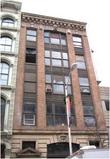
Turnbull Building – 311-313 W. Baltimore St. (Landmark #172)
The
Turnbull Building is an early 20th century factory and warehouse
constructed two years after the Baltimore Fire. The building was designed by
Bayard Turnbull, Baltimore architect, for his father, Lawrence Turnbull, as an
investment property. Lawrence Turnbull was a significant figure in literary
circles both in Baltimore and nationally. The building housed a variety of manufacturing firms
during the 20th century.
|
|